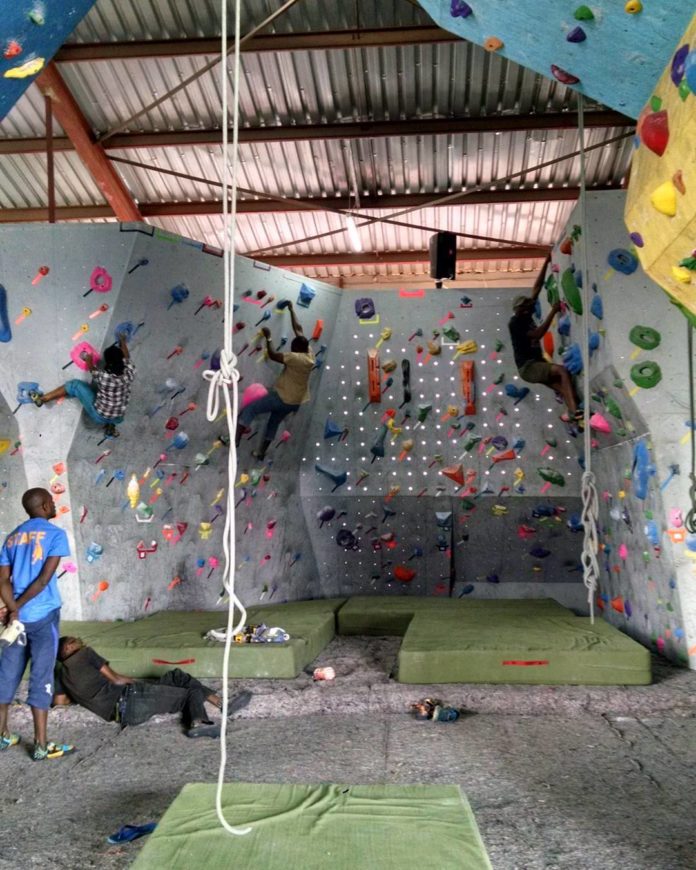Behind the Desk…is an ongoing series that profiles people influencing and advancing the industry in gyms around the country. This time CBJ heads down to Texas to talk about climbing on wooden barn walls, routesetting, youth teams, and climbing in Africa. It is a wide range of subjects, but it has all been part of the journey for Armadillo Boulders’ Andrew Andress.
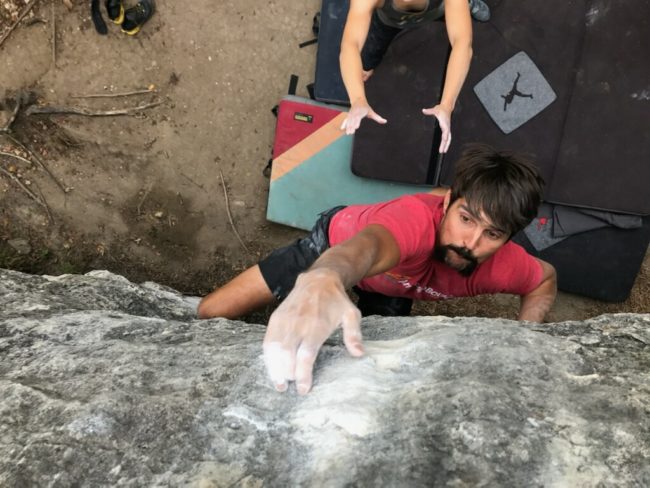
Name: Andrew Andress
Title: Operations Manager, Armadillo Boulders
Location: San Antonio, Texas
CBJ: Tell me about your climbing journey—how did climbing evolve into something you’d like to pursue as a career?
ANDRESS: My journey started very sporadically. I grew up in West Texas…not Hueco Tanks, but the dry dusty rockless part. I love sports and wanted to play them, but I was cut from every team sport I tried out for. So, I gravitated towards adventure sports like mountain biking. In the late 1990s my cousins converted an old barn into a low budget—but effective—‘woody.’ That place was my first foray into climbing, and at the time it seemed so extreme. I didn’t have a harness, so I learned to tie a rope harness…and even though we could have just bouldered, I felt like a mountain man top roping, learning knots, and belaying.
After a long journey of racing mountain bikes with unrealistic dreams of becoming a pro, I eventually lost the drive to go out and train for hours—usually alone or with minimal social interaction. In 2013, I ‘retired’ from bike racing, but I still loved the idea of training for something and setting goals. I reached out to a good friend of mine who was always trying to get me to climb more, and he took me to the local climbing gym. I showed up with an old harness…to a bouldering gym! That’s how out of touch with climbing I’d become! But at the end of the night, I purchased a membership and never looked back. Within a few months I developed a love for climbing technique. The technique and movement were what drew me to routesetting. I got to know that gym’s head routesetter and expressed an interest in setting there. I really just wanted to learn the basics, but it ended up being a volunteer position…then a job…then operating a climbing gym in East Africa, and now I’m very happy to be at Armadillo Boulders.
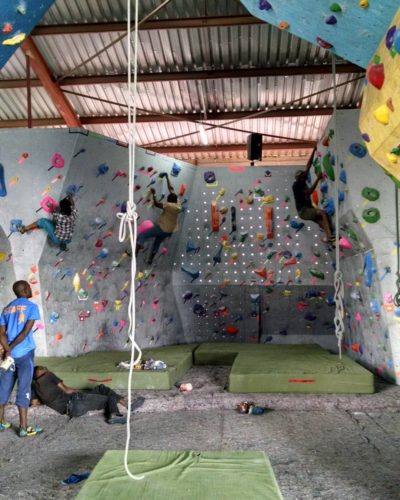
CBJ: East Africa! Can you please expound on that?
ANDRESS: Simply put, I was available and there was a need at a gym called Climb BlueSky in Nairobi, Kenya. I originally moved there to help operate the climbing gym and as the camp director for their summer youth camps. I transitioned to the role of Climb Director, with my focus being to help with renovating the gym, expanding membership and staff training. The gym had been built as a small community center with youth in mind; mostly it contained vertical top-rope walls with a tiny bouldering area. So, a major part of my role was to create ways to market the gym to more adults in the community, and to share the aspects of North American climbing gyms I loved the most. We were able to convert most of the space into a bouldering gym with everything from steep walls to slab sections. I think this was a big shift for both gym climbers and outdoor climbers in Kenya.
Also, Nairobi is such a multi-national city with the United Nations headquarters, embassies, mission organizations, NGOs, and a local demographic that is trending towards adventure and recreation. There is not a plethora of commercial outlets in Nairobi for recreation and fitness. Climb BlueSky filled that gap for many people. It became one of the mainstays for expats to connect with each other and invest in the local community very quickly. And on a personal note, BlueSky is where I met my wife, and she’s my number one climbing partner!
Since I’ve returned to the United States, Climb BlueSky is thriving, and is fully operated and staffed by Kenyans. This was a big goal of mine in my final two years there. I am happy I was able to help contribute additional value to the gym and I will always help partner with it in whatever way I can. The awesome local staff are leading the gym into the future, and continuing the growth of climbing in Kenya that they began with the community center.
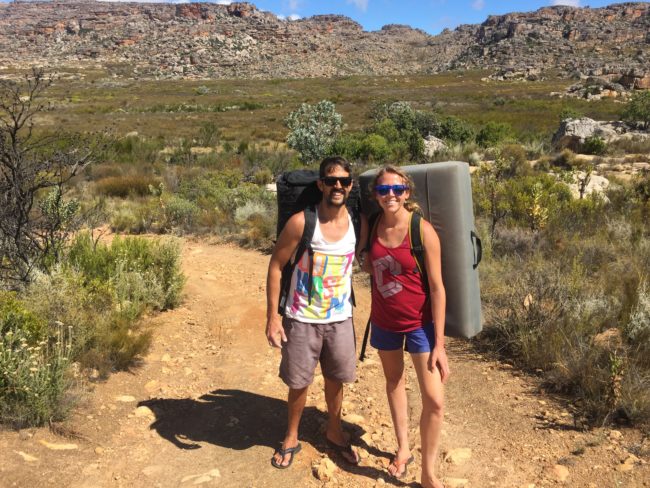
CBJ: Now, in addition to being the Operation Manager at Armadillo Boulders, you’re the head youth coach. What is the history of the youth program there at Armadillo?
ANDRESS: I think my title is now the Director of Climbing. But, yes, I am also the head coach of the gym’s youth team, ‘The Quesadillos,’ and they’re awesome and I love it!
The history is short, which I believe is what makes it so great. Our gym is just over a year old, and the team started a few weeks after we opened. One of our coaches, Jana Crawford, helped start it. She comes from a comp climbing background and her family owned a gym that was in San Antonio in the 1990s. We were going to be really happy if the Armadillo team had four kids in the first month…three of them being one of the owner’s kids. But within two months we had more kids than we could coach…so we had the conversation of having a waitlist, hosting tryouts, or hiring more coaches and adding more nights. We decided that if these kids want to come and train and are stoked on climbing, then our best service to them is to let them all come! I know what it feels like to be cut from teams, and I get that it’s part of life, but an awesome thing about climbing is the accessibility and enjoyment regardless of skill and experience.
CBJ: Tell me about Armadillo’s ‘Devo’ program—how is it different from a regular youth team program?
ANDRESS: Devo was a byproduct of us not having tryouts or a waitlist for the competition team. Basically, we were having kids show interest in the comp team, but transitioning them from recreational climbing with friends and family to comp practice was tough on the kids as well as coaches. So, we came up with a once a week Development Program [Devo] that is a prerequisite for the comp team. It has a similar layout but is much less intense. It is much more subjective, so kids should walk away from each day with a better understanding and practice of specific skills. As they hone these skills, kids who want to are able to do a trial week of the comp team before they decide what’s best for them.
The Devo program has quickly become our most high-demand youth program. It has also been a great landing place for kids who were on the comp team because they enjoyed climbing with kids their age but did not want the intensity of competition training. I knew once we started it that it would serve many roles. The kids who really want to be on the comp team communicate that with the coaches and they can get some more intensive training, while the kids who just love to climb with friends are free to do that while receiving instruction and walking away each day having learned a new technique or skill.
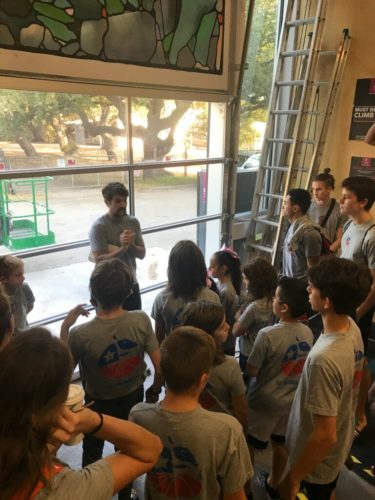
CBJ: I ask this for every Q&A, but I’m always intrigued by how different the answers are. What does community mean to Armadillo Boulders?
ANDRESS: Whether in Kenya or with team parents, community happens fast in a climbing gym. It’s such an amazing thing and mostly why I love climbing. Armadillo Boulders has member nights, comps, bouldering series, meetups, etc. All these things are amazing, but I see the community most when I walk in mid-morning and am able to spend some time with some of our incredible long-time members who are in their 50s and 60s, still so grateful that they found climbing. Then as the kids start to roll in during the afternoon, I love watching them hustle to get shoes on and warm up in hopes that they get a few climbs in before we start practice. It’s awesome how the rest of the gym’s members welcome the team and encourage the kids. Then I stay late and climb and I’m blown away by the progression of our members who love to come and climb, socialize, and train; everyone can’t wait to leave work or school the next day and do it all over again. It’s like a snow globe, maybe apropo with all the chalk. If you’re outside, you want to have the feeling that makes the inside so happy. And once you’re inside, you just want to stay.
CBJ: Since this column gets read by mostly other gym staffers and owners, what’s one thing that Armadillo does that you think other gyms should try?
ANDRESS: We’re still learning a lot. I really don’t have a great answer for this. We do have a good grasp of who we are. From the owners, managers, all the way through the staff. We are working to be better at a lot of things. Regardless, we know who we are, and we love climbing…and we get to share that every day.
Got a cool story? Tell us!
Do you know somebody who works in the climbing industry and would be good to profile in a Behind the Desk segment? (Or, do you work in the industry and have a personal background that you think others would enjoy learning about?) If so, please contact us and tell us about it!

John Burgman is the author of High Drama, a book that chronicles the history of American competition climbing. He is a Fulbright journalism grant recipient and a former magazine editor. He holds a master’s degree from New York University and bachelor’s degree from Miami University. In addition to writing, he coaches a youth bouldering team. Follow him on Twitter @John_Burgman and Instagram @jbclimbs. Read our interview Meet John Burgman, U.S. Comp Climbing’s Top Journalist.



